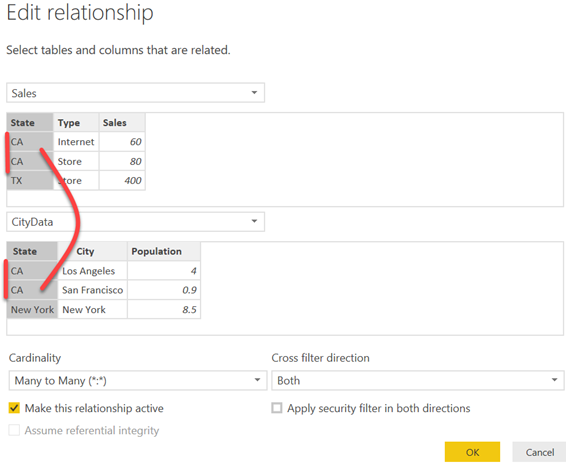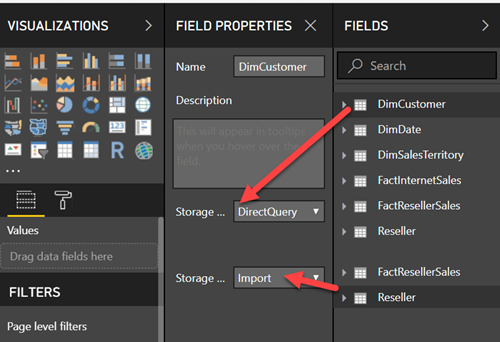Power BI Composite Models: The Good, The Bad, The Ugly
The July 2018 preview of Power BI Desktop delivers two killer preview features that solidify the Power BI position as the best data modeling tool for personal BI on the market. First, Microsoft relaxes the Power BI relationship limitations by letting you create M:M joins between two tables. Second, you can now create a composite (hybrid) data model with different storage modes, such as from an SQL Server database configured for DirectQuery and from an imported text file. Without reiterating the documentation, here are some important notes to keep in mind based on my pre-release testing.
The Good
M:M relationships remove a limitation that Power BI had since its Power Pivot days which is that one of the tables (the dimension or lookup table) must have a primary key: a field that uniquely identifies every row in the table. Now you can create a M:M relationship without requiring a bridge table, such as between two fact tables, as the screenshot shows. In this case, the Sales[State]-CityData[State] relationship is M:M because CA appears multiple times in each table. Previously, if you have attempted to create this relationship you would get an error message that the State field on the one side of the relationship is not unique.
The new M:M feature paves the way for supporting more flexible schemas but bear in mind that other relationship limitations, such as redundant paths and close-loop relationship are still not allowed. It also doesn’t mean that you shouldn’t follow best data modeling practices, such as star schemas.
For example, Power BI would disallow an active M:M relationship between ResellerSales and InternetSales fact tables if they’re joined to the same (conformed) dimensions. That’s because as it stands Power BI still doesn’t have a user interface to prompt the end user which path to take so it deactivates the relationship when it discovers a conflict.
Perhaps, a more important enhancement is ability to create data models with mixed storage modes which are referred to as “composite” models. Just two weeks ago I taught a Power BI class and the client disappointed that they can’t join SAP HANA and SQL Server in DirectQuery mode within the same Power BI model. That’s because previously DirectQuery was limited to single database. Now you can!
Composite models enable the following data acquisition options:
- Combine multiple databases from the same server in DirectQuery.
- Combine multiple data sources configured for DirectQuery
- Implement a hybrid storage model that combines a data source with imported data with another data source configured for DirectQuery.
- Combine a DirectQuery table with imported table from the same data source, such in the case where you prefer most tables to be imported but some in DirectQuery for real-time analysis.
Of course, DirectQuery is a double-edge sword. It lets you avoid importing data and eliminate latency, but performance depends on the data source so be careful. Aggregations (slated for later this year) could mitigate DirectQuery performance issues by letting you summarize data at a higher level.
The Bad
DirectQuery limitations continue to exist, including:
- Imported tables can’t be converted to DirectQuery and when attempting to do so, you’ll get an error “Imported tables can’t be converted to DirectQuery”. The reverse scenario, however, is supported. If the data source is DirectQuery, you can convert some tables to import data.
- DirectQuery can’t return more than 1 million rows. This has been a long standing DirectQuery limitation (documented here). Consider a DimCustomer table (from same or different source) that joins FactSales configured for DirectQuery and you request a report that shows sales by customer. At a certain (undisclosed by Microsoft) point it becomes inefficient to send the entire customer list to the WHERE clause of the FactSales direct query. Instead, the query would group FactSales at the Customer field used for the join, and then locally aggregate the results. However, if that query exceeds 1 million, then this would result in the query failing.
- Only a subset of data sources, such as popular relational databases and “fast” databases, support DirectQuery. I hope Microsoft extends DirectQuery to more data sources, such as Excel files and text files.
- You can’t pass parameters to custom SQL SELECT statement or stored procedure, such as to pass the value that the user selects in a slicer to a stored procedure configured for DirectQuery.
Composite models add a new twist to relationships. When combining two data sources in DirectQuery (or mixed) storage mode, Power BI converts all joins between the two data sources to be of M:M cardinality, irrespective of the actual cardinalities involved. According to Microsoft, this design was due to implementation challenges and the need to preserve performance. Although this isn’t a big issue, semantically I’d prefer the join cardinality to reflect the data cardinality. For example, if I join a DimCustomer table from SQLServerA with FactResellerSales from SQLServerB, the join cardinality should be 1:M. However, it’s not possible to configure 1:M for heterogeneous joins. Consequently, it’s not possible to validate the data is indeed 1:M and the RELATED DAX function won’t work. Microsoft believes that the cardinalities of the two end points are unimportant, the key difference between this type of relationship and the existing relationships is that it only supports cross-filtering, but not other semantics like RELATED function and blank rows from RI violation.
The Ugly
Power BI has always supported three data acquisition options: Import, DirectQuery, and Live Connection (multidimensional data sources only). You might have noticed that when you connect Power BI Desktop to Analysis Services, you’d see that the Data tab and Relationship tab are not available. That’s because Power BI morphs into a presentation layer to AS and passes through DAX queries. Unfortunately, as I explained in my blog “Power BI Feature Discrepancies for Data Acquisition“, Power BI treats DirectQuery and Live Connection data sources as second-class citizens and disables certain features.
Back to composite models, regretfully they don’t apply to multidimensional models: Analysis Services (MD and Tabular), Power BI datasets, and SAP HANA. In other words, a single Power BI desktop file is still limited to connecting to a single multidimensional database. I hope that Microsoft lifts this limitation at some point because it’s not uncommon to create a self-service model that needs to combine data from an organizational semantic model in DirectQuery and some other data source (imported or DirectQuery).
Composite models and M:M relationships are important new enhancements that bring even more flexibility to the Power BI data architecture. M:M relationships allows you to support more flexible schemas. Although old and new limitations exist, composite models lets you implement models with mixed storage modes to enable interesting data integration scenarios.






